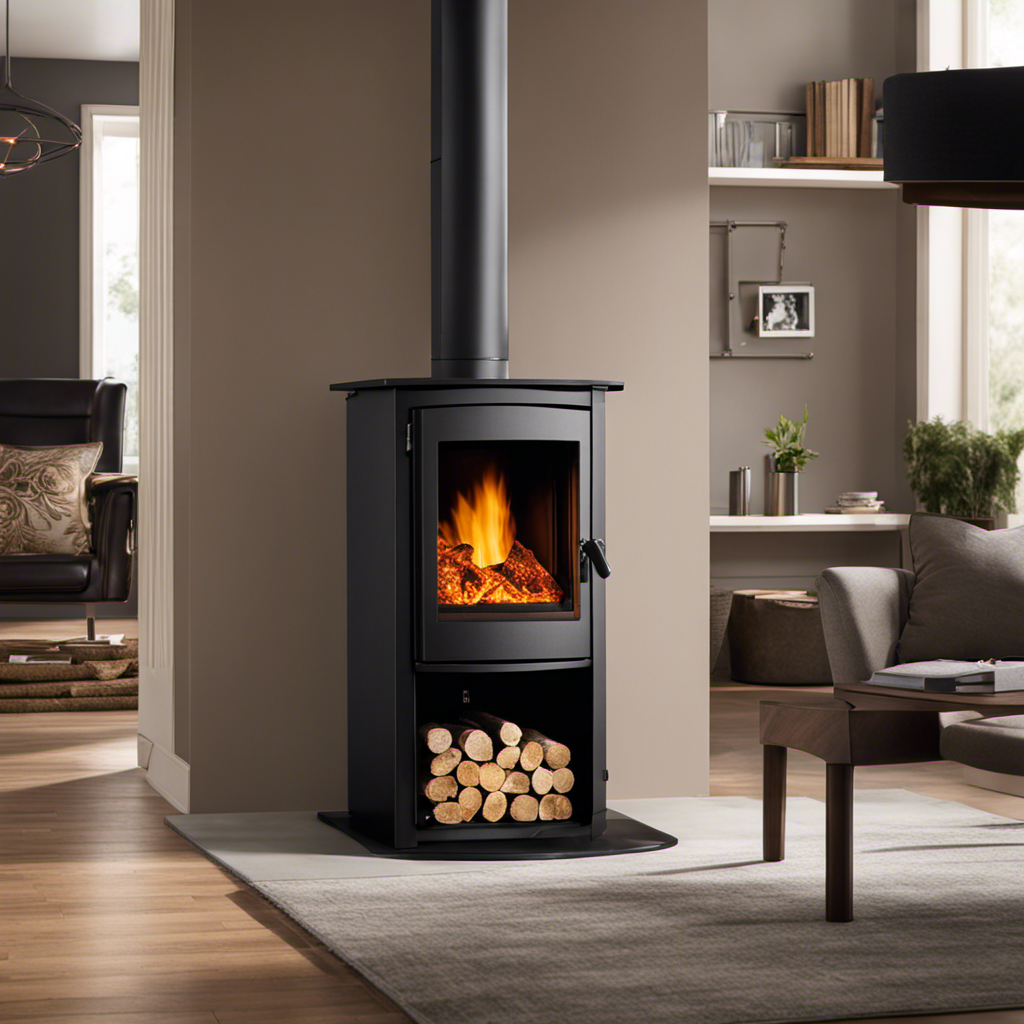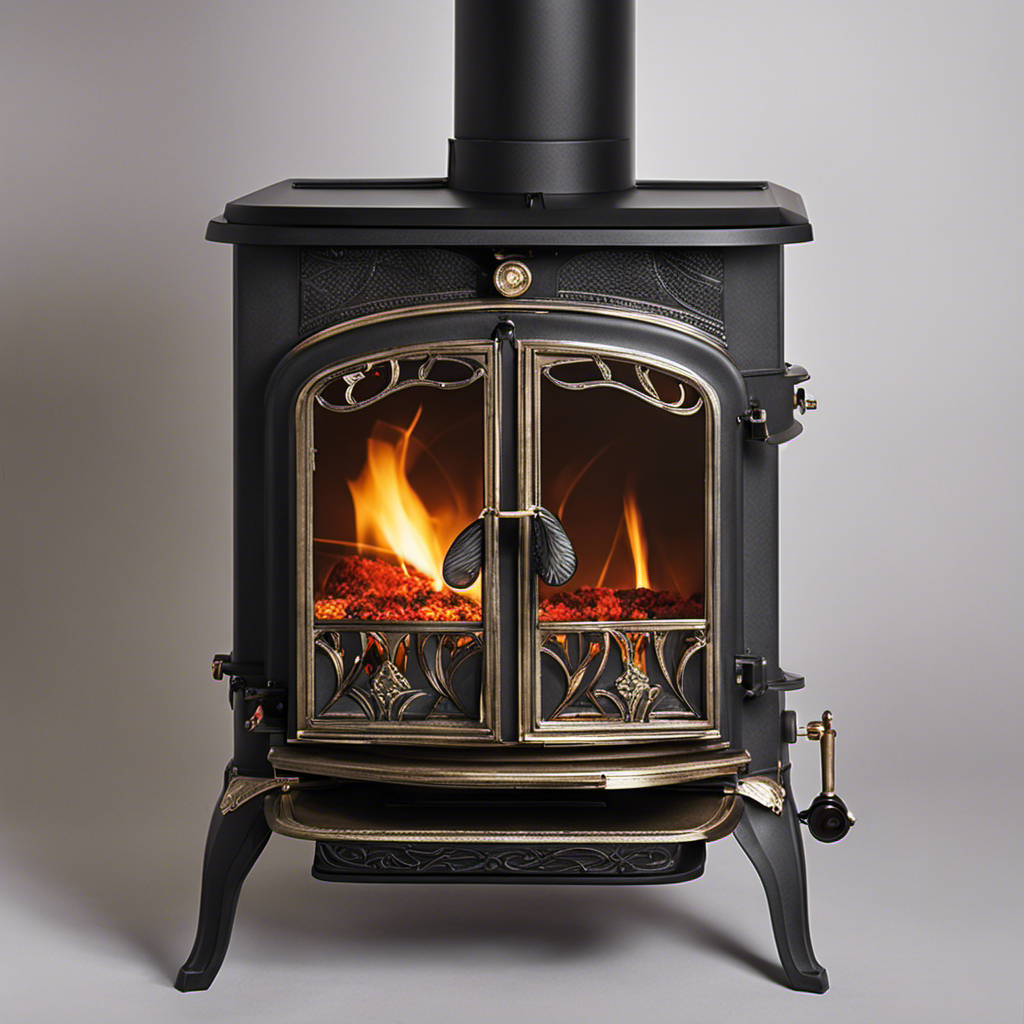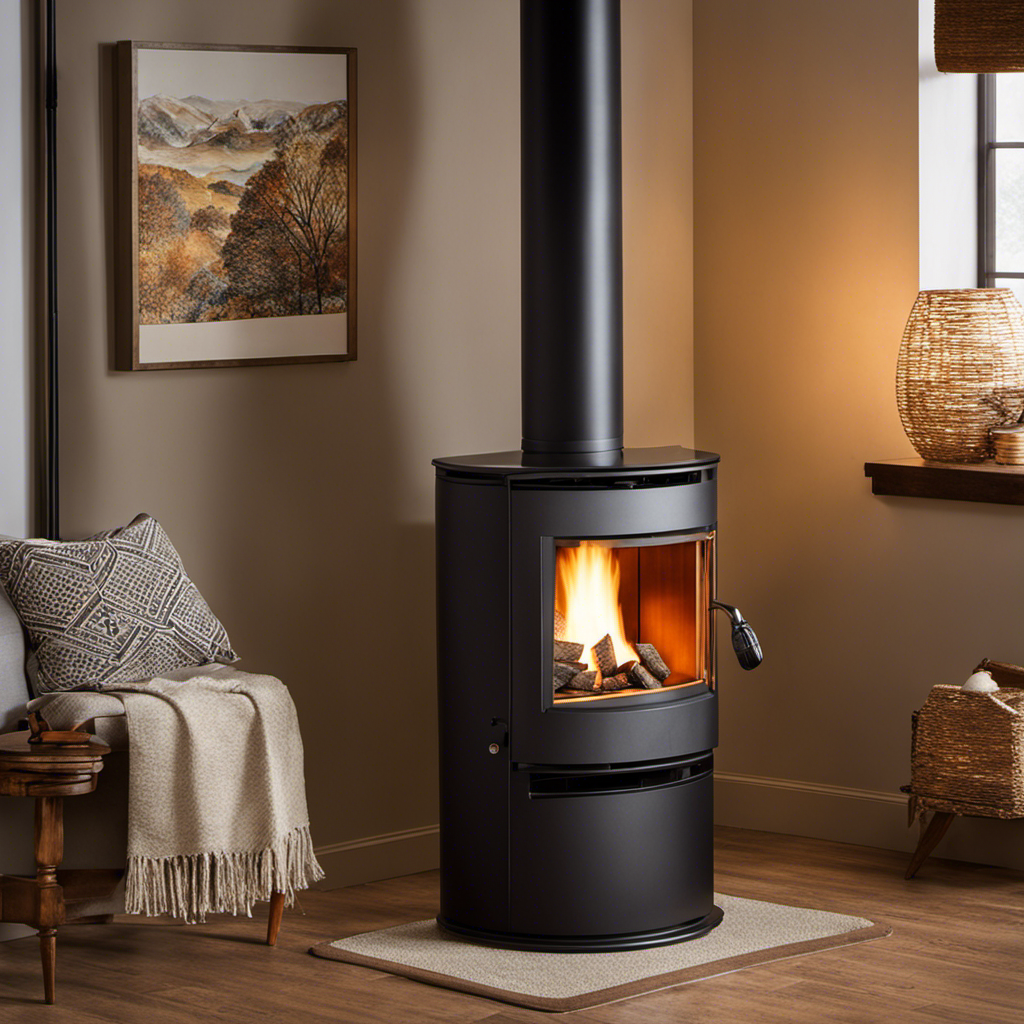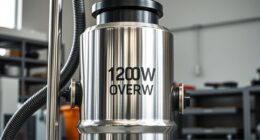Are you aiming to boost the warmth generated by your wood pellet stove? Good news! This article provides a series of professional advice and strategies to enhance the warmth your stove produces.
From choosing the right wood pellet fuel to optimizing airflow and exploring advanced heat recovery systems, we’ll cover it all.
Get ready to enhance the performance of your wood pellet stove and enjoy a cozy, warm environment all winter long.
Key Takeaways
- Placing the stove in a central location improves heat circulation.
- Regular cleaning and maintenance are necessary for optimal performance.
- Adjusting air intake and exhaust settings optimizes combustion and heat output.
- Proper airflow control and insulation enhance heat efficiency.
Understanding the Basics of Wood Pellet Stoves
To understand the basics of wood pellet stoves, you’ll need to know how they work and what makes them different from traditional wood-burning stoves.
Wood pellet stoves are designed to burn wood pellets, which are small, compressed pieces of sawdust and other biomass materials. They work by feeding the pellets into a combustion chamber, where they are ignited and burned to produce heat. The heat is then transferred to the surrounding area through a heat exchanger or blower system.
Maintaining a wood pellet stove involves regular cleaning of the ash pan and chimney, as well as checking and replacing any worn out or damaged parts. Common issues that may arise include poor pellet combustion, inadequate heat output, and issues with ignition or fuel feed. Troubleshooting these issues may require adjusting the air-to-fuel ratio, cleaning or replacing the igniter, or adjusting the fuel feed rate.
Choosing the Right Wood Pellet Fuel for Maximum Heat Output
When it comes to maximizing the efficiency of your pellet stove and achieving optimal heat output, the choice of fuel plays a crucial role.
The type and quality of wood pellets used can greatly impact the performance of your stove.
In this discussion, I will delve into the key points of selecting the right wood pellet fuel for maximum heat output and how it can enhance the overall efficiency of your pellet stove.
Fuel for Optimal Heat
Using the right type of fuel can maximize the heat output of your wood pellet stove. Here are some key factors to consider when choosing fuel for optimal heat:
-
Pellet Size: Choosing the correct pellet size is crucial for maximizing combustion efficiency. Smaller pellets tend to burn more efficiently and produce more heat.
-
Moisture Content: Opt for pellets with a low moisture content. High moisture content can hinder combustion and reduce heat output.
-
Ash Content: Look for pellets with a low ash content. High ash content can lead to more frequent cleaning and decreased heat transfer.
-
Density: Higher density pellets tend to burn longer and produce more heat. Choose pellets with a higher density for optimal heat output.
-
Quality: Always select high-quality pellets to ensure consistent heat output and efficient combustion.
By considering these factors, you can improve heat transfer and maximize the heat output of your wood pellet stove.
Consequently, this will lead to higher overall efficiency in your pellet stove operation.
Maximizing Pellet Stove Efficiency
By considering these factors, you can improve the overall efficiency of your wood pellet stove.
Maximizing energy efficiency is essential for getting the most heat output from your stove. One way to achieve this is by improving heat circulation. Ensure that your stove is placed in a central location, away from walls or obstructions that can block the airflow. Clean the stove regularly to remove any built-up dust or debris that can hinder heat circulation. Additionally, using a fan or blower can help distribute the heat more evenly throughout the room.
Optimizing airflow for increased heat efficiency is crucial. By adjusting the air intake and exhaust settings, you can control the combustion process and achieve a more efficient burn, resulting in increased heat output.
Optimizing Airflow for Increased Heat Efficiency
To maximize heat efficiency, it’s important to optimize the airflow in your wood pellet stove. By properly managing the airflow, you can achieve optimal temperature control and improve pellet combustion.
One key aspect is ensuring that the air intake and exhaust vents are clean and free from any obstructions. This allows for a smooth and consistent flow of fresh air into the stove and the release of combustion gases.
Additionally, adjusting the damper and fan settings can help regulate the amount of air entering the stove, thereby optimizing the burning process. By fine-tuning these airflow controls, you can achieve better heat output and reduce fuel consumption.
With an optimized airflow system, you can now turn your attention to properly insulating your wood pellet stove, which further enhances its heat efficiency.
Properly Insulating Your Wood Pellet Stove
Now that we have optimized the airflow in our wood pellet stove, let’s move on to another important aspect of increasing its heat output: properly insulating the stove.
Insulating the stove offers numerous benefits, such as reducing heat loss and improving efficiency. Here are some techniques to ensure proper insulation:
- Use high-quality insulation materials, such as ceramic fiber blanket or refractory cement, to line the interior of the stove.
- Seal any gaps or cracks in the stove with heat-resistant caulk or gaskets to prevent air leakage.
- Insulate the exhaust pipe to minimize heat loss during the venting process.
By properly insulating your wood pellet stove, you can maximize its heat output and ensure efficient operation.
Now, let’s move on to the next section, where we will discuss cleaning and maintaining the stove for better performance.
Cleaning and Maintaining the Stove for Better Performance
Regularly cleaning and maintaining your stove is essential for optimal performance and longevity. To keep your wood pellet stove running smoothly, it is important to follow proper cleaning methods.
Start by shutting off the stove and allowing it to cool down. Remove the ash pan and empty it into a metal container. Use a soft brush or vacuum with a brush attachment to clean the inside of the stove, removing any debris or ash buildup. Pay close attention to the burn pot and heat exchanger, as these areas are prone to clogging.
Additionally, regularly inspect and clean the exhaust vent to ensure proper airflow. Troubleshooting tips include checking the hopper for obstructions and inspecting the igniter for any signs of damage. By properly cleaning and maintaining your stove, you can ensure it operates at its best, providing efficient heat output.
Now, let’s move on to adjusting the feed rate for higher heat output.
Adjusting the Feed Rate for Higher Heat Output
Adjusting the feed rate on your stove will result in a higher level of heat. This can be done by turning a dial or adjusting a lever, depending on the specific model of your wood pellet stove. Increasing the feed rate increases the amount of fuel being fed into the combustion chamber, which in turn increases the heat output. However, it is important to note that increasing the feed rate will also lead to an increase in fuel consumption. Therefore, it is necessary to find the right balance between heat output and fuel efficiency.
To do this, you can adjust the thermostat settings to ensure that the stove operates at its optimal temperature. By finding the right combination of feed rate and thermostat settings, you can maximize the heat output while minimizing fuel consumption.
Transitioning into the subsequent section about enhancing combustion efficiency with regular maintenance, it is important to note that adjusting the feed rate and thermostat settings is just one aspect of optimizing the performance of your wood pellet stove. Another crucial factor is regular maintenance to enhance combustion efficiency.
Enhancing Combustion Efficiency With Regular Maintenance
To enhance the combustion efficiency of a wood pellet stove, there are three key points to consider: cleaning stove components, adjusting air intake, and using quality pellets.
Regularly cleaning the stove components, such as the burn pot, heat exchanger, and flue, helps to remove any build-up of ash and debris that can hinder proper combustion.
Adjusting the air intake allows for better control of the combustion process, ensuring optimal burning conditions.
Lastly, using high-quality pellets with low moisture content and minimal impurities can greatly improve the overall efficiency and performance of the stove.
Cleaning Stove Components
Cleaning the stove components is an effective way to increase the heat output of a wood pellet stove. One important aspect of this maintenance is cleaning the stove grates regularly. Over time, ash buildup can accumulate on the grates, reducing the airflow and hindering efficient combustion.
To clean the stove grates, start by allowing the stove to cool down completely. Next, remove the grates carefully and brush off any loose ash or debris. For stubborn buildup, use a wire brush or scraper to gently remove the residue. Once the grates are clean, reinsert them into the stove and ensure they are properly aligned.
By regularly cleaning the stove grates and removing ash buildup, you can optimize the airflow and combustion process, resulting in increased heat output.
Now, let’s move on to adjusting the air intake for further heat enhancement.
Adjusting Air Intake
After thoroughly cleaning the components of the wood pellet stove, the next step in increasing heat output is adjusting the air intake. Maximizing airflow is crucial for efficient combustion and optimal heat production.
Here are some key points to consider when adjusting the damper:
- Start by locating the air intake damper, usually found on the front or side of the stove.
- Open the damper fully to allow maximum airflow when starting the stove.
- Once the fire is established, gradually close the damper to regulate the amount of oxygen entering the combustion chamber.
- Monitor the flame and adjust the damper accordingly to maintain a steady, hot burn.
- Remember that the right balance of air intake is essential for both heat output and fuel efficiency.
Now that we’ve optimized the airflow, let’s move on to the next section about using quality pellets to further enhance heat production.
Using Quality Pellets
When using quality pellets in your stove, you’ll notice a significant improvement in efficiency and heat production. Quality pellets are made from compressed wood or biomass, and they burn cleaner and more efficiently than lower quality pellets. They have a higher heat output and produce less ash and emissions, resulting in a more efficient and eco-friendly heating experience.
Additionally, using alternative fuels such as corn or cherry pits can further enhance the heat output of your wood pellet stove. These alternative fuels have higher energy content and can provide a longer burn time.
Another way to increase the heat output of your stove is by increasing insulation around the stove. This prevents heat loss and ensures that more heat is directed into the room.
Now, let’s explore how using heat reflectors can maximize heat distribution throughout your space.
Using Heat Reflectors to Maximize Heat Distribution
To maximize heat distribution in your wood pellet stove, try using heat reflectors.
Heat reflectors are designed to increase the efficiency and effectiveness of your stove by directing the heat towards the desired area.
These reflectors are typically made from heat resistant materials such as aluminum or stainless steel, which can withstand the high temperatures generated by the stove.
By positioning the reflectors strategically, you can maximize heat reflection and ensure that it is evenly distributed throughout your living space.
This not only helps to keep your home warm, but also reduces energy consumption and saves you money.
In addition to using heat reflectors, exploring the benefits of a heat recovery system can further enhance the efficiency of your wood pellet stove.
This system allows you to capture and reuse the heat that is typically lost through the stove’s exhaust, providing even more warmth and cost savings.
Exploring the Benefits of a Heat Recovery System
When it comes to the efficiency of heat recovery systems, there are several factors to consider.
These systems are designed to capture and reuse waste heat, allowing for more efficient energy usage.
Additionally, heat recovery systems can be cost-effective in the long run, as they reduce the need for additional heating or cooling systems and can lead to significant energy savings.
Efficiency of Heat Recovery
You can improve the efficiency of heat recovery in your wood pellet stove by cleaning the exhaust vents regularly. This is important because a clean exhaust vent allows for better airflow, which in turn maximizes the heat recovery system’s performance.
Here are two key reasons why cleaning the exhaust vents is crucial:
-
Prevents blockages: Over time, soot, ash, and other debris can build up in the exhaust vents, obstructing the flow of exhaust gases. By cleaning these vents, you can avoid blockages and ensure that the system operates at its peak efficiency.
-
Reduces heat loss: A clean exhaust vent helps to minimize heat loss during the heat recovery process. Any obstructions or buildup in the vent can cause the heat to escape before it can be effectively captured and utilized.
Cost-Effectiveness of System
Maintaining clean exhaust vents in your wood pellet stove enhances the system’s efficiency, resulting in a more cost-effective performance. To further increase cost-effectiveness, consider implementing a few key upgrades and energy-saving tips.
First, ensure that your stove is properly sized for your space to optimize heat output. Additionally, installing a programmable thermostat allows for precise temperature control and reduces energy waste. Upgrading to a high-efficiency model with advanced combustion technology can also significantly improve fuel utilization and reduce operating costs.
Regularly cleaning and inspecting your stove, including the heat exchanger, will prevent efficiency losses and potential malfunctions. By implementing these cost-effective upgrades and energy-saving tips, you can maximize the efficiency of your wood pellet stove and save on heating costs.
Transitioning into the next section, let’s explore the potential of supplementing heat output with a heat exchanger.
Supplementing Heat Output With a Heat Exchanger
Using a heat exchanger can help you increase the heat output of your wood pellet stove. It’s a cost-effective and efficient way to recover and utilize wasted heat. Here are some benefits of heat recovery through heat exchanger installation:
-
Increased heat output: By capturing and utilizing the excess heat produced by your stove, you can significantly increase the amount of heat generated.
-
Energy savings: Heat recovery reduces the need for additional fuel, resulting in lower energy consumption and cost savings.
-
Improved indoor air quality: The heat exchanger helps remove harmful gases and pollutants from the exhaust, creating a healthier environment.
-
Environmental friendliness: By maximizing heat output and minimizing waste, heat recovery reduces greenhouse gas emissions and promotes sustainability.
Considering upgrades and modifications for increased heat output, there are various options to explore.
Considering Upgrades and Modifications for Increased Heat Output
Now that we have explored the option of supplementing heat output with a heat exchanger, let’s consider some upgrades and modifications that can further increase the heat output of a wood pellet stove.
One effective way to maximize heat retention is by upgrading the insulation of the stove. This can be done by adding additional layers of insulation to the stove, which will help to minimize heat loss and improve overall efficiency.
Another important aspect to consider is improving combustion within the stove. This can be achieved by ensuring proper air intake, adjusting the fuel-to-air ratio, and regularly cleaning the stove to prevent any buildup or blockages that may hinder combustion.
Frequently Asked Questions
Can I Use Regular Firewood in a Wood Pellet Stove?
No, you cannot use regular firewood in a wood pellet stove. Wood pellets are specifically designed for these stoves and offer many benefits, such as higher heat output, cleaner burning, and more efficient combustion.
How Often Should I Clean My Wood Pellet Stove?
I clean my wood pellet stove every month to ensure optimal performance. Regular cleaning helps remove ash buildup, which can impact heat output. Here are some maintenance tips: clean the burn pot, check the exhaust system, and inspect the hopper for any blockages.
Is It Safe to Leave a Wood Pellet Stove Unattended?
Leaving a wood pellet stove unattended is not recommended due to safety concerns. It is important to take necessary precautions, such as turning off the stove and ensuring proper ventilation, to prevent any potential risks or accidents.
Can I Use a Wood Pellet Stove to Heat My Entire House?
Yes, a wood pellet stove can effectively heat an entire house. Proper wood pellet stove maintenance is crucial for optimal performance. The benefits include cost savings, efficient heating, and environmental friendliness.
How Much Will It Cost to Upgrade My Wood Pellet Stove for Increased Heat Output?
Calculating the cost of upgrading your wood pellet stove for increased heat output depends on various factors. However, it’s essential to consider the long-term benefits, such as improved efficiency and a warmer home.
Conclusion
In conclusion, by implementing the strategies and techniques discussed in this article, you can greatly enhance the heat output of your wood pellet stove.
With the right fuel, optimized airflow, proper insulation, regular maintenance, and the use of heat reflectors, heat recovery systems, and heat exchangers, you can create a furnace-like atmosphere in your home.
Consider exploring upgrades and modifications to further increase the heat output and enjoy the cozy warmth and comfort that only a well-tuned wood pellet stove can provide.
Growing up surrounded by the vast beauty of nature, Sierra was always drawn to the call of the wild. While others sought the comfort of the familiar, she ventured out, embracing the unpredictable and finding stories in the heartbeat of nature.
At the epicenter of every remarkable venture lies a dynamic team—a fusion of diverse talents, visions, and passions. The essence of Best Small Wood Stoves is crafted and refined by such a trio: Sierra, Logan, and Terra. Their collective expertise has transformed the platform into a leading authority on small wood stoves, radiating warmth and knowledge in equal measure.











